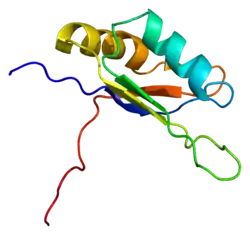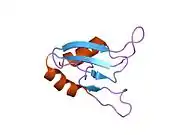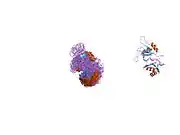| ELAVL3 | |||||||||||||||||||||||||||||||||||||||||||||||||||
|---|---|---|---|---|---|---|---|---|---|---|---|---|---|---|---|---|---|---|---|---|---|---|---|---|---|---|---|---|---|---|---|---|---|---|---|---|---|---|---|---|---|---|---|---|---|---|---|---|---|---|---|
 | |||||||||||||||||||||||||||||||||||||||||||||||||||
| |||||||||||||||||||||||||||||||||||||||||||||||||||
| Identifiers | |||||||||||||||||||||||||||||||||||||||||||||||||||
| Aliases | ELAVL3, HUC, HUCL, PLE21, ELAV like neuron-specific RNA binding protein 3, ELAV like RNA binding protein 3 | ||||||||||||||||||||||||||||||||||||||||||||||||||
| External IDs | OMIM: 603458 MGI: 109157 HomoloGene: 31035 GeneCards: ELAVL3 | ||||||||||||||||||||||||||||||||||||||||||||||||||
| |||||||||||||||||||||||||||||||||||||||||||||||||||
| |||||||||||||||||||||||||||||||||||||||||||||||||||
| |||||||||||||||||||||||||||||||||||||||||||||||||||
| |||||||||||||||||||||||||||||||||||||||||||||||||||
| Wikidata | |||||||||||||||||||||||||||||||||||||||||||||||||||
| |||||||||||||||||||||||||||||||||||||||||||||||||||
ELAV-like protein 3 is a protein that in humans is encoded by the ELAVL3 gene.[5][6]
A member of the ELAVL protein family, ELAV-like 3 is a neural-specific RNA-binding protein which contains three RNP-type RNA recognition motifs. The observation that ELAVL3 is one of several Hu antigens (neuronal-specific RNA-binding proteins) recognized by the anti-Hu serum antibody present in sera from patients with paraneoplastic encephalomyelitis and sensory neuronopathy (PEM/PSN) suggests it has a role in neurogenesis. Two alternatively spliced transcript variants encoding distinct isoforms have been found for this gene.[6]
References
- 1 2 3 GRCh38: Ensembl release 89: ENSG00000196361 - Ensembl, May 2017
- 1 2 3 GRCm38: Ensembl release 89: ENSMUSG00000003410 - Ensembl, May 2017
- ↑ "Human PubMed Reference:". National Center for Biotechnology Information, U.S. National Library of Medicine.
- ↑ "Mouse PubMed Reference:". National Center for Biotechnology Information, U.S. National Library of Medicine.
- ↑ Van Tine BA, Knops JF, Butler A, Deloukas P, Shaw GM, King PH (Dec 1998). "Localization of HuC (ELAVL3) to chromosome 19p13.2 by fluorescence in situ hybridization utilizing a novel tyramide labeling technique". Genomics. 53 (3): 296–9. doi:10.1006/geno.1998.5468. PMID 9799595.
- 1 2 "Entrez Gene: ELAVL3 ELAV (embryonic lethal, abnormal vision, Drosophila)-like 3 (Hu antigen C)".
Further reading
- Rual JF, Venkatesan K, Hao T, et al. (2005). "Towards a proteome-scale map of the human protein-protein interaction network". Nature. 437 (7062): 1173–8. Bibcode:2005Natur.437.1173R. doi:10.1038/nature04209. PMID 16189514. S2CID 4427026.
- Gerhard DS, Wagner L, Feingold EA, et al. (2004). "The status, quality, and expansion of the NIH full-length cDNA project: the Mammalian Gene Collection (MGC)". Genome Res. 14 (10B): 2121–7. doi:10.1101/gr.2596504. PMC 528928. PMID 15489334.
- Strausberg RL, Feingold EA, Grouse LH, et al. (2003). "Generation and initial analysis of more than 15,000 full-length human and mouse cDNA sequences". Proc. Natl. Acad. Sci. U.S.A. 99 (26): 16899–903. Bibcode:2002PNAS...9916899M. doi:10.1073/pnas.242603899. PMC 139241. PMID 12477932.
- Behrends U, Jandl T, Golbeck A, et al. (2002). "Novel products of the HUD, HUC, NNP-1 and alpha-internexin genes identified by autologous antibody screening of a pediatric neuroblastoma library". Int. J. Cancer. 100 (6): 669–77. doi:10.1002/ijc.10550. PMID 12209604. S2CID 35369661.
- Park S, Myszka DG, Yu M, et al. (2000). "HuD RNA recognition motifs play distinct roles in the formation of a stable complex with AU-rich RNA". Mol. Cell. Biol. 20 (13): 4765–72. doi:10.1128/MCB.20.13.4765-4772.2000. PMC 85909. PMID 10848602.
- Sakai K, Kitagawa Y, Hirose G (1999). "Analysis of the RNA recognition motifs of human neuronal ELAV-like proteins in binding to a cytokine mRNA". Biochem. Biophys. Res. Commun. 256 (2): 263–8. doi:10.1006/bbrc.1999.0282. PMID 10079173.
- Sakai K, Gofuku M, Kitagawa Y, et al. (1994). "A hippocampal protein associated with paraneoplastic neurologic syndrome and small cell lung carcinoma". Biochem. Biophys. Res. Commun. 199 (3): 1200–8. doi:10.1006/bbrc.1994.1358. PMID 7511893.
This article is issued from Wikipedia. The text is licensed under Creative Commons - Attribution - Sharealike. Additional terms may apply for the media files.










